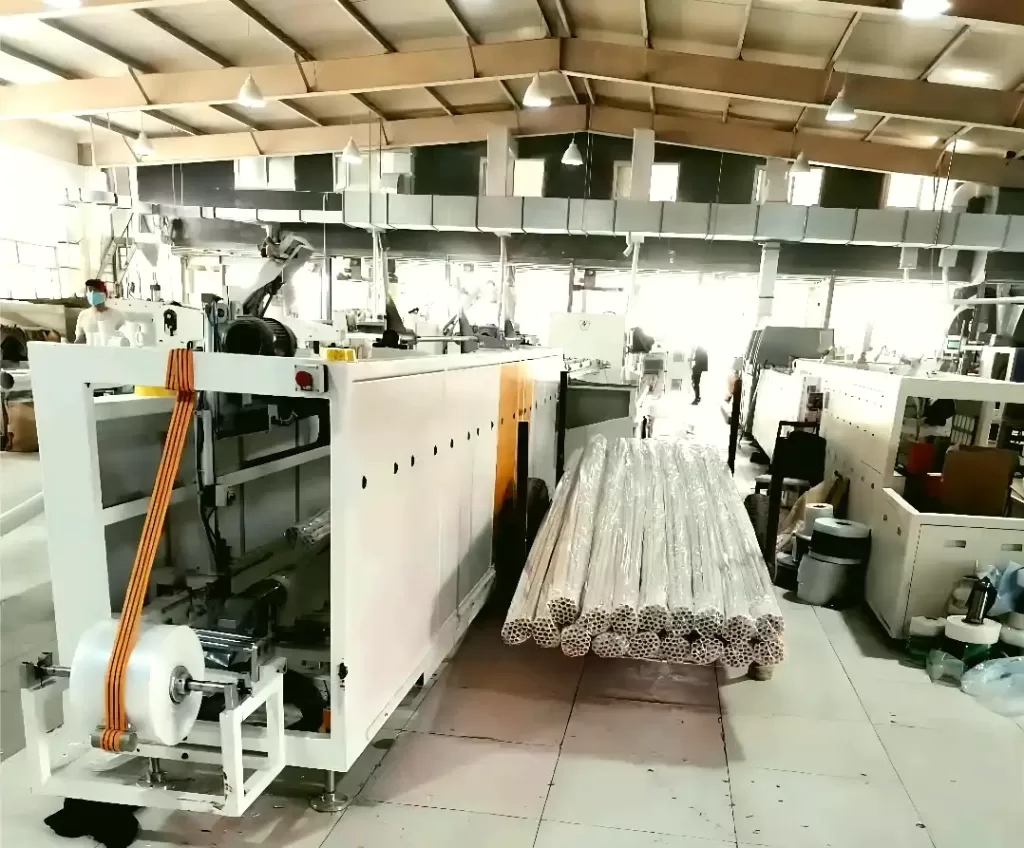Streamlining Operations: Understanding Automatic Pipe Bagging and Tube Bundle Strapping Systems
Handling and packaging pipes and tubes efficiently and safely is a crucial step in many manufacturing and fabrication workflows. Manual processes can be labor-intensive, inconsistent, and pose potential risks to both products and personnel. Automatic pipe bagging and tube bundle strapping systems offer a sophisticated solution, automating the collection, bundling, securing, and protective wrapping of various pipe and tube types. This article explores the functionality, components, benefits, and considerations associated with these integrated packaging lines.
Video caption: Example of an automated system processing and packaging pipes.
Further details on specific configurations can be found, such as solutions tailored for PPR/PVC pipe bagging lines.
What is an Automatic Pipe Bagging and Strapping System?
An automatic pipe bagging machine combined with a tube bundle strapping machine is an integrated packaging line designed to streamline the end-of-line process for pipe and tube products. The system typically performs several functions sequentially:
- Collection: Gathers individual pipes or tubes directly from the production line or a staging area.
- Counting & Collation: Accurately counts the required number of pieces for a bundle.
- Bundle Formation: Arranges the counted items into a predetermined bundle shape (e.g., hexagonal, square).
- Strapping: Applies bands or straps (often plastic or steel) around the bundle to provide initial structural integrity.
- Bagging/Wrapping: Encases the strapped bundle in a protective plastic bag or film (like stretch film) for environmental protection and handling ease.

online pipe bundling ang bagging machine3 How the Process Works: A Step-by-Step Overview
While specific configurations vary, a typical automated process includes:
- Infeed: Pipes or tubes are fed onto the system, often via roller conveyors or feeding arms.
- Counting & Stacking: Sensors detect and count pieces as they move into a collation area, where they are stacked or nested to form the desired bundle shape.
- Bundle Transfer: The formed bundle is transferred to the strapping station.
- Strapping: One or more strapping heads automatically apply, tension, seal, and cut straps at designated positions around the bundle.
- Transfer to Bagging/Wrapping: The strapped bundle moves to the next station.
- Bagging/Wrapping:
- Bagging: A pre-made bag may be automatically opened and placed over the bundle, or a bag is formed from film around the bundle, followed by sealing.
- Wrapping: Alternatively, the bundle might be wrapped circumferentially with stretch film.
- Sealing/Cutting (if applicable): The bag is sealed (e.g., heat-sealed) and excess material trimmed.
- Outfeed: The finished, packaged bundle is discharged from the machine, ready for storage or shipment.
Key Components and Technologies
These systems integrate several technologies:
- Conveyor Systems: Roller, belt, or chain conveyors manage material flow.
- Sensors & Vision Systems: Ensure accurate counting, positioning, and quality checks.
- Mechanical Arms/Actuators: Handle pipe manipulation, stacking, and bundle transfer.
- Strapping Heads: Automated units that feed, tension, seal (heat or friction weld), and cut strapping material. Details on advanced systems like an Automatic Steel Tube Packing Line often highlight specific strapping head capabilities.
- Bagging/Wrapping Units: Mechanisms for dispensing film, forming bags, sealing, or applying stretch wrap.
- Programmable Logic Controllers (PLCs): The central control unit managing the sequence, timing, and coordination of all components.
- Human-Machine Interface (HMI): Touchscreen panels allowing operators to monitor the process, adjust parameters, and troubleshoot issues.

automatic pipe bagging machine for pvc and ppr Benefits of Automated Pipe Packaging
Implementing an automatic pipe bagging machine and tube bundle strapping machine offers significant advantages:
- Increased Throughput: Automation significantly speeds up the packaging process compared to manual methods.
- Consistency: Ensures uniform bundle shapes, strap tension, and wrapping quality for every package.
- Product Protection: Secure strapping prevents bundle collapse, while bagging/wrapping protects against dust, moisture, and surface scratches during transit and storage.
- Labor Optimization: Reduces the need for manual handling, freeing up personnel for other tasks.
- Enhanced Safety: Minimizes manual lifting and interaction with strapping tools, reducing potential ergonomic injuries.
- Improved Logistics: Neatly packaged bundles are easier to handle, stack, and inventory.
Considerations for Implementation
Before investing in an automated system, factors to evaluate include:
- Product Range: The system must accommodate the diameters, lengths, weights, and materials of the pipes/tubes being processed.
- Bundle Specifications: Define the required bundle size, shape, and weight.
- Throughput Requirements: Match the machine's capacity to the production line's output.
- Packaging Materials: Compatibility with desired strapping (e.g., PP, PET, steel) and bagging/wrapping materials (e.g., PE film).
- Integration: How the system connects with upstream and downstream processes.
- Footprint: Available floor space for the machine and operational clearances.
- Maintenance: Requirements for routine servicing and spare parts availability.
Safety Protocols are Paramount
Operating any automated machinery requires strict adherence to safety protocols.
- Training: Ensure all operators receive comprehensive training on machine operation, safety features, and emergency procedures.
- Personal Protective Equipment (PPE): Mandate the use of appropriate PPE, such as gloves and safety glasses, when working near the machine.
- Guarding: Verify all machine guards are in place and functional.
- Lockout/Tagout: Implement rigorous lockout/tagout procedures during maintenance and servicing.
- Manufacturer Guidelines: Always follow the specific safety and operational instructions provided by the equipment manufacturer. Referencing established safety guidelines is also recommended practice.
- Regular Maintenance: Conduct routine inspections and preventative maintenance to ensure continued safe and reliable operation.

plastic pipe bundle making and bagging machine (3) Conclusion
Automatic pipe bagging and tube bundle strapping machines represent a significant technological step forward for industries handling large volumes of pipe and tube products. By automating the bundling, strapping, and wrapping processes, these systems deliver enhanced efficiency, consistency, product protection, and operational safety. Careful consideration of application requirements and adherence to safety best practices are key to successfully integrating this technology and realizing its full benefits in streamlining packaging operations.